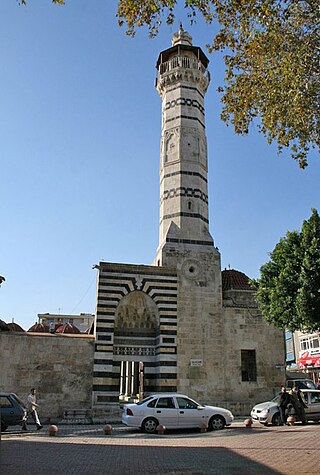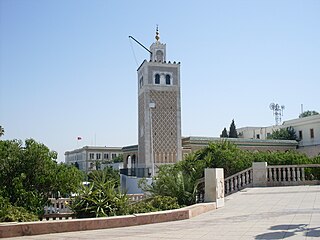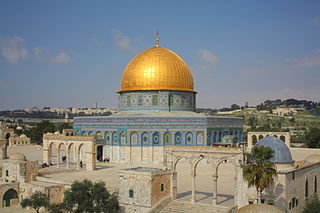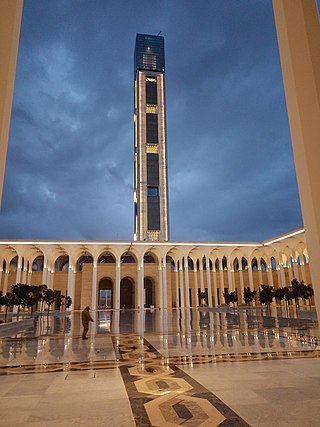Related Research Articles

Hagia Sophia, officially the Hagia Sophia Grand Mosque, is a mosque and former church serving as a major cultural and historical site in Istanbul, Turkey. The last of three church buildings to be successively erected on the site by the Eastern Roman Empire, it was completed in 537 CE. The site was a Greek Orthodox church from 360 CE to 1453, except for a brief time as a Latin Catholic church between the Fourth Crusade and 1261. After the fall of Constantinople in 1453, it served as a mosque until 1935, when it became a museum. In 2020, the site once again became a mosque.

The Aqsa Mosque, also known as the Qibli Mosque or Qibli Chapel, is the main congregational mosque or prayer hall in the Al-Aqsa mosque compound in the Old City of Jerusalem. In some sources the building is also named al-Masjid al-Aqṣā, but this name primarily applies to the whole compound in which the building sits, which is itself also known as "Al-Aqsa Mosque". The wider compound is known as Al-Aqsa or Al-Aqsa mosque compound, also known as al-Ḥaram al-Sharīf.

The Blue Mosque in Istanbul, also known by its official name, the Sultan Ahmed Mosque, is an Ottoman-era historical imperial mosque located in Istanbul, Turkey. It was constructed between 1609 and 1617 during the rule of Ahmed I and remains a functioning mosque today. It also attracts a large number of tourists and is one of the most iconic and popular monuments of Ottoman architecture.

The Prophet's Mosque is the second mosque built by the Islamic prophet Muhammad in Medina, after that of Quba, as well as the second largest mosque and holiest site in Islam, after the Masjid al-Haram in Mecca, in the Saudi region of the Hejaz. The mosque is located at the heart of Medina, and is a major site of pilgrimage that falls under the purview of the Custodian of the Two Holy Mosques.

The Selimiye Mosque is an Ottoman imperial mosque, located in the city of Edirne, Turkey. It was commissioned by Sultan Selim II and was built by the imperial architect Mimar Sinan between 1568 and 1575. It was considered by Sinan to be his masterpiece and is one of the highest achievements of Islamic architecture as a whole and Ottoman architecture in particular.

The Bibi-Khanym Mosque is one of the most important monuments of Samarkand, Uzbekistan. In the 15th century, it was one of the largest and most magnificent mosques in the Islamic world. It is considered a masterpiece of the Timurid Renaissance. By the mid-20th century, only a grandiose ruin of it still survived, but major parts of the mosque were restored during the Soviet period.

The Akhmad Kadyrov Mosque is located in Grozny, the capital of Chechnya. The mosque is one of the largest in Russia and is officially known as "The Heart of Chechnya".

The Great Mosque of Adana, also known as the Ramazanoglu Mosque Turkish: Ramazanoğlu Camii), is a 16th-century mosque in Adana, Turkey. It forms part of a complex (külliye) that includes a madrasah and a mausoleum (türbe). The buildings are on Kızılay street, next to the Ramazanoğlu Hall.

Kasbah Mosque is a mosque in Tunis, Tunisia. It is a listed as a Historical Monument.

The Tuba-Shahi Mosque is a historical and architectural monument of the 15th century located in the Mardakan village of the Khazar district in Baku (Azerbaijan). The mosque is included in the list of the historical and architectural monuments of local importance approved by the Cabinet of Ministers of the Republic of Azerbaijan. It was built not far from the Quadrangular Mardakan Castle dating back to the era of the Shirvanshahs.

The Mosque of Amir Altinbugha al-Maridani, dating from 1340 CE, is a mosque from the era of the Mamluk Sultanate of Cairo, Egypt. Located south of Bab Zuweila, in the Darb al-Ahmar neighbourhood, it was built on what was then the outskirts of medieval Cairo by Amir Altinbugha al-Maridani, with significant help from Sultan al-Nasir Muhammad. The mosque has a hypostyle plan similar to the Mosque of al-Nasir, and its exterior walls are decorated in typical Mamluk architecture style. At the time of its building, it was one of the most extravagantly decorated mosques in Cairo, marked by the first fully octagonal minaret and large dome, as well as other architectural innovations. Its history and luxuriousness are directly correlated to the life and prominence of al-Maridani, as it was built with the patronage of his father-in-law, the sultan, and significant donations from al-Maridani's own fortune.

Green Mosque is a historic Ottoman mosque in İznik, Turkey.
The Gurbanguly Hajji Mosque is a mosque in Mary, Turkmenistan. It was completed in 2009, during the rule of Gurbanguly Berdimuhamedov. It is a prominent landmark in Mary with its four minarets.

Umayyad architecture developed in the Umayyad Caliphate between 661 and 750, primarily in its heartlands of Syria and Palestine. It drew extensively on the architecture of older Middle Eastern and Mediterranean civilizations including the Sassanian Empire and Byzantine Empire, but introduced innovations in decoration and form. Under Umayyad patronage, Islamic architecture began to mature and acquire traditions of its own, such as the introduction of mihrabs to mosques, a trend towards aniconism in decoration, and a greater sense of scale and monumentality compared to previous Islamic buildings. The most important examples of Umayyad architecture are concentrated in the capital of Damascus and the Greater Syria region, including the Dome of the Rock, the Great Mosque of Damascus, and secular buildings such as the Mshatta Palace and Qusayr 'Amra.

Almaty Central Mosque is one of the largest mosques in Almaty, and in Kazakhstan. Designed for 7000 worshippers, it was built on the site of the old mosque that dated to 1890 and caught fire in 1987.

Djamaa el Djazaïr, also known as the Great Mosque of Algiers, is a large mosque located in Algiers, Algeria. Opened in April 2019, it houses the world's tallest minaret and is the third-largest mosque in the world after the Great Mosque of Mecca and Al-Masjid an-Nabawi of Medina in Saudi Arabia.

Aqmescit Friday Mosque, also known as the Great Friday Mosque and the Simferopol Cathedral Mosque named after Noman Çelebicihan is the largest mosque in Aqmescit (Simferopol), Crimea, which had been under construction since 2015 after Russian annexation of the Crimean peninsula. It opened on 9 December 2023.

The Imam Hussein Mosque or Ashumov Mosque is a historical and architectural monument dating back to the 19th century. It is located in the city of Baku, Azerbaijan.

The Arap Mosque also known as the Mosque of the Law Courts is a historical Ottoman-era mosque in the town of Drama, Eastern Macedonia, in Greece. Left neglected for almost a century, it is undergoing restoration as of November 2022.

The Gasimbey Mosque is a historical architectural monument dating back to the 19th century, located in the city of Baku, Azerbaijan.
References
- ↑ "В Ашхабаде торжественно открыта новая мечеть". Archived from the original on 2020-02-23. Retrieved 2020-02-23.
- ↑ "Президент Туркменистана принял участие в открытии мечети в Лебапском велаяте". Archived from the original on 2020-02-28. Retrieved 2020-02-23.
- ↑ В Ашхабаде в преддверии Дня независимости открыли новую мечеть
- ↑ В жилом массиве Ашхабада открылась крупная мечеть